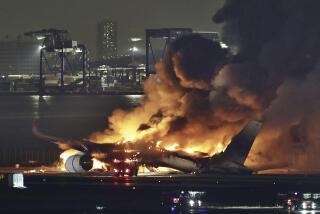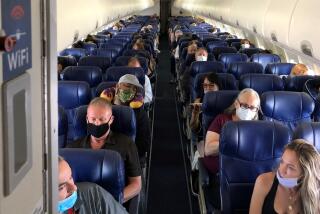Study Tests Effects of Smoking in Planes : Finds Little or No Protection From Exposure in Nonsmoker Sections
- Share via
A seat in the nonsmoking section of an airplane may offer little or no protection against tobacco smoke, according to a new federal study that found no significant difference in the exposures of passengers in smoking sections and nonsmoking areas nearby.
The study, done at the request of the U.S. Surgeon General and to be published Friday in the Journal of the American Medical Assn., documented for the first time the existence of breakdown products of nicotine in the urine of nonsmoking passengers.
It is not clear what effects such exposures might have on the health of nonsmoking passengers. But researchers note that so-called passive smoke has been blamed for several thousand lung cancer deaths annually in nonsmokers.
“The bottom line is just because you’re sitting in the nonsmoking section doesn’t mean you’re protected from the toxins, carcinogens and irritants that result from people smoking,” said Joseph W. Cullen of the National Cancer Institute, an author of the study.
“When you’re talking about an exposure to smoke which contains 4,000 chemicals, including 43 known to cause cancer, you would want to totally eliminate that exposure,” said Dr. Ronald M. Davis, director of the Office on Smoking and Health of the Centers for Disease Control.
Members of Congress, health officials and anti-smoking activists welcomed the findings Wednesday. They said the report lends strong support to their efforts to extend the current two-year trial ban on smoking on domestic flights of up to two hours duration.
But tobacco industry officials faulted the study, calling it small, poorly designed and biased. They said the data suggested to them that smoke exposure on the flights was minimal and insufficient to justify any ban.
“We’re not talking about health effects,” said Dr. David Weeks, a physician in Boise, Ida., who is a consultant to the Tobacco Institute, the cigarette manufacturers’ trade association. “We’re only talking about exposure.”
The study, said by researchers to be the first to compare the biological effects of smoke exposure in smoking and nonsmoking passengers, examined the experiences of five passengers and four flight attendants who flew on four flights each. Each flight was about four hours long.
The passengers sat either in the smoking section or in a nonsmoking area bordering it. The flight attendants worked in either smoking or nonsmoking. All test participants were nonsmokers and had no respiratory diseases or problems.
Each wore a badge capable of detecting nicotine--a so-called marker for smoke, which also contains many other contaminants. Before and for three days after each flight, their urine was collected and tested for cotinine, a breakdown product of nicotine.
The group also answered detailed questionnaires about perceived smoke exposure: Did their eyes itch, burn, become dry or teary? Was their nose stuffy? Did they develop a sore throat, headaches, a cough or sneezing?
Smoke levels varied widely throughout the planes, the researchers found. They were also higher on planes with half-recirculated, rather than all fresh air. But there was no significant difference in exposure between the smoking and nonsmoking areas studied.
Smoke Exposures
In some cases, the badge and urine sample results revealed that passengers in nonsmoking areas were exposed to more smoke than those in smoking areas. The degree of annoyance and eye and nose irritation was in direct proportion to the intensity of smoke exposure, the researchers found.
“I think the point is that it’s very annoying to have people smoking on airplanes, and the symptoms people report are not just imagined because they hate smokers,” said Dr. David Byar of the Division of Cancer Prevention and Control at the cancer institute.
“We don’t know what the risk is, if there’s an actual health risk,” added Byar, one of the report’s co-authors. “But it just doesn’t seem right that you have to excrete somebody else’s poison.”
Numerous studies have linked passive or involuntary smoke to respiratory diseases and lung cancer among nonsmokers. The National Academy of Sciences has estimated that 2,400 lung cancer deaths a year among nonsmokers are caused by environmental tobacco smoke.
In response to those reports, the Congress enacted last April the two-year trial ban on smoking on short flights. Several bills have been introduced in the current Congress to make that ban permanent or to extend it to all flights.
“This is going to help us,” Congressman Dick Durbin, author of the original smoking-ban bill, said Wednesday of the new study. “It makes it clear that there’s no such thing as a nonsmoking section on a flight with smokers.”
Study Faulted
But Weeks and Walker Merryman, vice president of the Tobacco Institute, faulted the study for using too few subjects and being poorly conceived. For example, Weeks said, it would be necessary to compare the experiences of these passengers to those of passengers on nonsmoking flights.
“We are taking an overly simplistic view of the indoor environment,” said Weeks, suggesting that poor ventilation and allergies are to blame. “If you restrict smoking, all you’re going to get out of it is fewer complaints about tobacco smoke. It doesn’t mean you’re going to get less illness.”
Byar and Cullen defended the small numbers of subjects used in the study, saying previous studies had shown those numbers would be sufficient to detect differences in the effects of exposures. Others argued that it is misleading to argue that no health effect has been proven in planes.
“If you know something causes cancer and other diseases, you don’t have to prove that it’s harmful in every setting in which one might find oneself in order to take appropriate public health action,” said Davis of the Centers for Disease Control.






